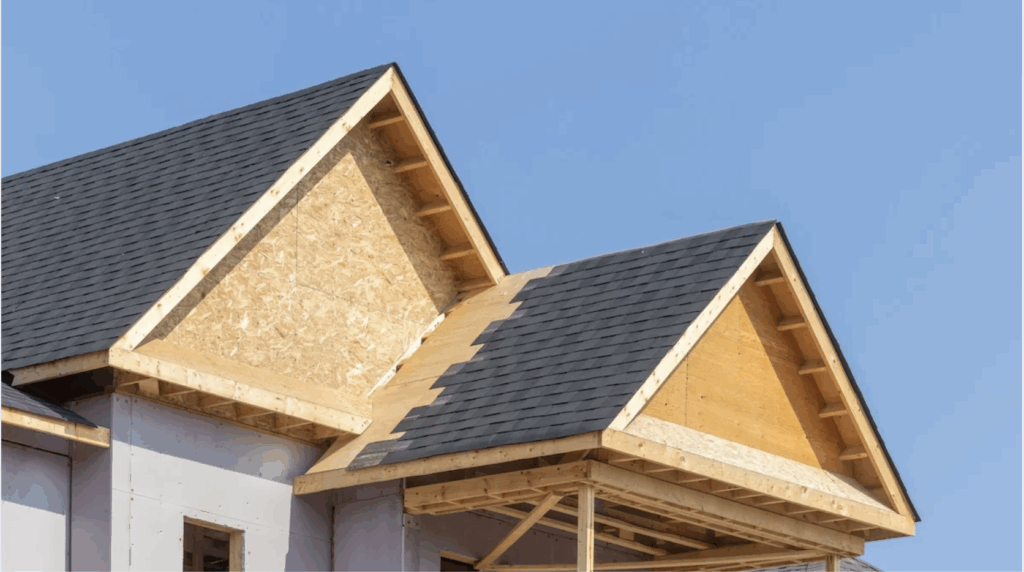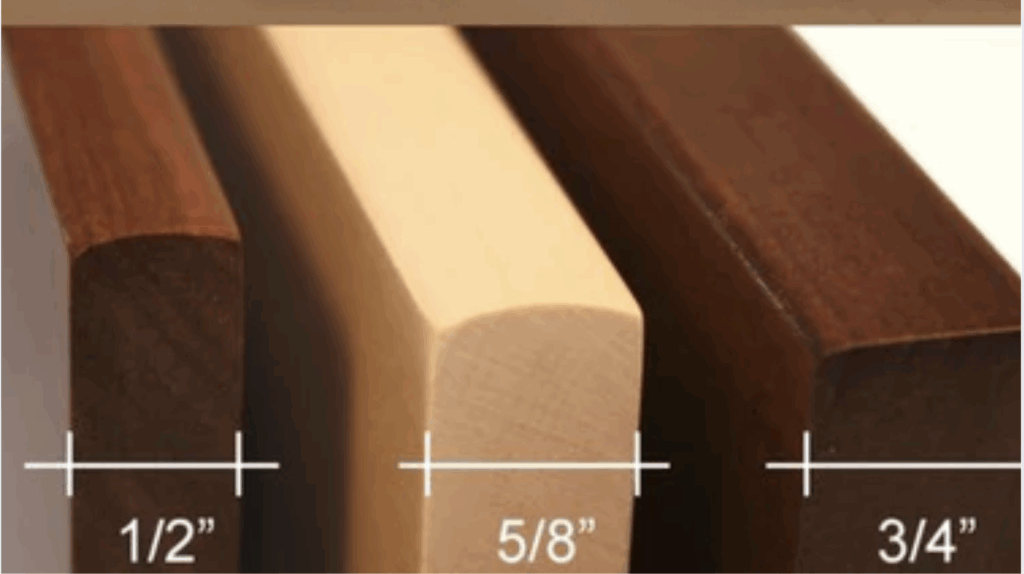When it comes to choosing the right thickness for your roof sheathing, do you find yourself stuck between 1/2 inch and 5/8 inch options?
I get it, making this decision is important, and it’s not always clear which one will be the best fit for your project.
As someone who’s worked on several roofing projects, I’ve seen how the right thickness can impact everything from cost to durability.
In this blog, I’ll break down the key differences between these two options and help you decide which one works best for your needs.
By the end, you’ll have all the info you need to make a confident choice.
What Is Roof Sheathing and Why Is It Important?
Roof sheathing is the layer of material that sits directly on top of your rafters, acting as the base for your roofing material.
Think of it as the foundation of your roof, providing support and a surface for shingles, tiles, or whatever roofing system you choose.
I’ve worked on many roofs over the years, and I can tell you, sheathing is often overlooked but plays a huge role in the overall stability of the roof.
It helps with weight distribution, prevents water from seeping into your home, and adds structural integrity.
Without proper sheathing, your roof might not stand up to heavy rain, snow, or even just the wear and tear of time. Trust me, it’s not a step you want to skip.
How to Choose the Right Roof Sheathing Thickness

When choosing the right roof sheathing thickness, consider factors like your needs, climate, roofing materials, and budget to make an informed decision.
1. Sheathing Material
The material used for roof sheathing plays a significant role in determining the appropriate thickness. Let’s see common materials:
- Plywood: A traditional and trusted choice, plywood is known for its strength and durability. It provides solid support and performs well in various weather conditions.
- Oriented Strand Board (OSB): A more affordable alternative, OSB is becoming increasingly popular due to its cost-effectiveness. While it may not offer the same level of durability as plywood, it’s still a reliable option for many roof types.
- Metal Sheets: Often used for metal roofing systems, metal sheets are strong and can be a great option for specific applications. The thickness required depends on the type of metal and the roofing system in place.
2. Dimensions of Panels and Truss Spacing
When selecting the right sheathing thickness, the spacing of trusses plays a key role. Consider the following:
- Truss Spacing: Standard truss spacing is usually 16 or 24 inches, though it can vary based on design and building codes.
- Thicker Sheathing for Wider Spacing: If trusses are spaced farther apart, thicker sheathing is needed to prevent sagging.
- Closer Spacing in Harsh Conditions: In areas with heavy snow or high winds, trusses may need to be placed closer for extra support, affecting the sheathing thickness.
- Increased Load Handling: Closer truss spacing means the sheathing must handle more load and resist sagging effectively.
3. Roof Application Type
The type of roof you’re working with has a significant impact on sheathing thickness choices. Consider the following factors:
- Steep-slope roofs: These often require thicker sheathing to support heavier roofing materials such as tiles or slate.
- Low-slope or flat roofs: These may require additional considerations, such as water resistance, as they tend to have more drainage issues.
- Snow and wind loads: Areas with heavy snow or high winds often have stricter regulations regarding sheathing thickness. The added weight from snow or the force of high winds demands extra durability from the roof structure.
Complex roof designs, such as those with multiple valleys, hips, or dormers, may also require thicker sheathing to ensure even support across the roof.
Comparing Roof Sheathing Thickness: 1/2 Inch vs. 5/8 Inch

When selecting roof sheathing thickness, common options include 1/2 inch and 5/8 inch. Each has its benefits, depending on your needs.
1/2 Inch Sheathing
This thickness is often used with Plywood or Oriented Strand Board (OSB). It’s a popular choice for standard homes with moderate roofing needs.
Suitability: 1/2 inch sheathing is well-suited for homes in moderate climates that don’t experience heavy snow or wind.
It’s the go-to option for basic residential roofs where the load is fairly typical, such as asphalt shingles.
I’ve used this thickness many times when working on standard single-family homes, and it offers a good balance between cost and performance.
Advantages:
- Cost-effective: 1/2 inch sheathing is less expensive compared to thicker options, making it a good choice if you’re working with a budget.
- Standard Strength: Provides adequate support for lightweight roofing materials like asphalt shingles.
- Easier to Handle: Lighter weight can make installation faster and easier, especially if you’re working on a DIY project.
Tips: If your roof has wide truss spacing or you’re using lightweight shingles, 1/2 inch sheathing can be a perfect fit. Just make sure your local building codes allow for it based on your specific roof design.
5/8 Inch Sheathing
Like 1/2 inch, Plywood and OSB are common materials, but the thicker 5/8 inch version offers added durability and support.
Suitability: 5/8 inch sheathing is a great option for homes in regions with harsher weather conditions, like areas with heavy snow or strong winds.
I’ve found this thickness especially useful for homes with more complex roof designs or when installing heavier roofing materials, such as tile or metal.
It provides added strength and resistance, making it ideal for supporting roofs that face additional stress.
Advantages:
- Stronger Support: Provides more resistance to sagging between trusses, which is especially important for wider truss spacing.
- Better Durability: Works well with heavier roofing materials, ensuring the structure holds up over time. It’s also a better choice for homes in areas with high wind or snow loads.
- Improved Stability: Adds more structural integrity to the roof, helping it withstand the elements and last longer.
Tips: If you’re building a house in an area with extreme weather, or if you plan to use heavier materials, I recommend stepping up to 5/8 inch sheathing. It’s also a good choice for more complicated roof structures.
Other Thickness Options (3/4 Inch and 7/16 Inch)
- 3/4 Inch: Ideal for roofing projects needing more strength than 1/2 inch but less than 5/8 inch. Common in garages, sheds, and moderate climates where extra support is needed.
- 7/16 Inch: A thinner option used for lightweight roofs in mild climates, such as sheds or temporary buildings, where less support is required. Not suitable for standard homes.
Choosing the Right Thickness for Your Roof
Ultimately, the choice between 1/2 inch and 5/8 inch sheathing will depend on your home’s needs. Let’s see a breakdown to help:
| Sheathing Thickness | Benefits | Recommendation |
|---|---|---|
| 1/2 Inch | Budget-friendly, ideal for typical residential projects | Good for standard homes |
| 5/8 Inch | More durable, stable, and ideal for long-term performance | Worth the investment for homes with challenging weather conditions |
In my experience, when in doubt, I always opt for the thicker option if my budget allows. It provides better long-term performance, especially for homes in areas with challenging weather.
Roof Sheathing Thickness: Quick Comparison Table
This table breaks down the key differences between common roof sheathing thicknesses. It helps you choose the right thickness based on material type, climate, roof design, and your specific needs.
| Thickness | Material | Suitability | Advantages | Best For |
|---|---|---|---|---|
| 1/2 Inch | Plywood, OSB | Ideal for standard homes in moderate climates with lightweight roofing materials like asphalt shingles. | – Cost-effective- Standard strength for lightweight roofs- Easier to handle during installation | Typical residential homes, moderate climates, basic roofs |
| 5/8 Inch | Plywood, OSB | Great for homes in regions with heavy snow or wind, or when using heavier roofing materials like tile or metal. | – Stronger support- Better durability- Improved stability under stress | Homes in harsher climates, complex roofs, and heavy roofing materials |
| 3/8 Inch | Plywood, OSB | Suitable for smaller or lightweight structures like sheds or garages, or homes in mild climates. | – Lightweight- Cost-effective for small structures- Easy to install | Sheds, garages, mild climates |
| 1 Inch | Plywood, OSB | Used for flat or low-slope roofs, or in areas with higher moisture exposure and additional strength needs. | – Extra durability- Moisture resistance- Strong support for specialized applications | Flat/low-slope roofs, areas with heavy moisture, and specialized uses |
This table should help you make a more informed decision when selecting the appropriate thickness for your roof sheathing.
Maintenance and Long-Term Considerations
When choosing roof sheathing thickness, consider its long-term maintenance benefits. This is what to keep in mind:
- Durability: Thicker sheathing (like 5/8 inch) offers better durability and fewer repairs over time.
- Climate Impact: 1/2 inch sheathing can show signs of wear in harsh climates, especially with constant moisture or snow.
- Resistance to Damage: Thicker sheathing is more resistant to water damage, potentially saving on future repairs.
- Stability: Thicker sheathing helps prevent sagging, making long-term maintenance easier.
- Long-Term Investment: Although thicker sheathing may cost more initially, it offers better performance and reliability over time.
Conclusion
Choosing the right roof sheathing thickness depends on your specific needs, from the climate you live in to the type of roofing material you’re using.
In my experience, 1/2 inch sheathing works well for standard homes in mild weather, while 5/8 inch offers added strength for more challenging conditions or heavier materials.
It’s always important to consider factors like truss spacing, roof design, and budget.
When building a new home or replacing existing sheathing, I hope this guide helps you make an informed decision.
The right choice will not only support your roof but also ensure it lasts for years to come.

